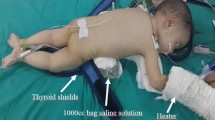Abstract
Paediatric nephrolithiasis is seen more and more frequently, with patients often presenting to the emergency department with acute symptoms requiring immediate evaluation and treatment. The pain is usually due to a stone stuck at some level of the ureter, causing variable degree of obstruction. Aside from symptoms control, the paediatric urologist has to plan the best strategy for the stone treatment. This varies from medical therapy only to a series of surgical procedure aimed at releasing the obstruction and removing the stone completely. Nowadays, a widely adopted approach to ureteric stones is ureteroscopy, which has shown high stone-free rates and low post-operative complications in expert hands. It can be performed as an emergency or planned as an elective procedure after a safe pre-stenting of the affected ureter. Dealing with paediatric nephrolithiasis needs surgeons who master endourology and a theatre staff confident with all the instruments potentially necessary, in order to be able to choose and change the surgical strategy upon specific patient and stone features.
Access this chapter
Tax calculation will be finalised at checkout
Purchases are for personal use only
Similar content being viewed by others
References
Pietrow PK, Pope JC 4th, Adams MC, Shyr Y, Brock JW 3rd. Clinical outcome of pediatric stone disease. J Urol. 2002;167(2 Pt 1):670–3.
Velázquez N, Zapata D, Wang HH, Wiener JS, Lipkin ME, Routh JC. Medical expulsive therapy for pediatric urolithiasis: systematic review and meta-analysis. J Pediatr Urol. 2015;11(6):321–7.
Aydogdu O, Burgu B, Gucuk A, Suer E, Soygur T. Effectiveness of doxazosin in treatment of distal ureteral stones in children. J Urol. 2009;182(6):2880–4.
Minevich E, Defoor W, Reddy P. Ureteroscopy is safe and effective in prepubertal children. J Urol. 2005;174:276–9.
Dogan HS, Onal B, Satar N. Factors affecting the complication rates of ureteroscopic lithotripsy in children: results of multi-institutional retrospective analysis by Pediatric Stone Disease Study Group of Turkish Pediatric Urology Society. J Urol. 2011;186:1035–40.
Atar M, Sancaktutar AA, Penbegul N. Comparison of a 4.5 F semi-rigid ureteroscope with a 7.5 F rigid ureteroscope in the treatment of ureteral stones in preschool-age children. Urol Res. 2012;40:733–8.
Nerli RB, Patil SM, Guntaka AK. Flexible ureteroscopy for upper ureteral calculi in children. J Endourol. 2011;25:579–82.
Esposito C, Masieri L, Bagnara V, Tokar B, Golebiewski A, Escolino M. Ureteroscopic lithotripsy for ureteral stones in children using holmium: yag laser energy: results of a multicentric survey. J Pediatr Urol. 2019;15(4):391.e1–7.
Çitamak B, Mammadov E, Kahraman O, Ceylan T, Doğan HS, Tekgül S. Semi-rigid ureteroscopy should not be the first option for proximal ureteral stones in children. J Endourol. 2018;32(11):1028–32.
Ishii H, Griffin S, Somani BK. Ureteroscopy for stone disease in the paediatric population: a systematic review. BJU Int. 2015;115(6):867–73.
Mokhless I, Zahran AR, Youssif M, Fahmy A. Tamsulosin for the management of distal ureteral stones in children: a prospective randomized study. J Pediatr Urol. 2012;8:544–8.
Lu J, Sun X, He L, Wang Y. Efficacy of extracorporeal shock wave lithotropsy for ureteral stones in children. Pediatr Surg Int. 2009;25(12):1109–12.
Gokce MI, Telli O, Akinci A, Esen B, Suer E, Ozkidik M, Hajiyev P, Soygur T, Burgu B. Effect of prestenting on success and complication rates of ureterorenoscopy in pediatric population. J Endourol. 2016;30(8):850–5.
Jessen JP, Breda A, Brehmer M, Liatsikos EN, Millan Rodriguez F, Osther PJ, Scoffone CM, Knoll T. International collaboration in endourology: multicenter evaluation of prestenting for ureterorenoscopy. J Endourol. 2016;30(3):268–73.
Kaygısız O, Satar N, Güneş A, Doğan HS, Erözenci A, Özden E, Pişkin MM, Demirci D, Toksöz S, Çiçek T, Gürocak S, Kılıçarslan H, Nazlı O, Kefi A, İzol V, Beytur A, Sarıkaya Ş, Tekgül S, Önal B. Factors predicting postoperative febrile urinary tract infection following percutaneous nephrolithotomy in prepubertal children. J Pediatr Urol. 2018;14(5):448.
Tang L, Gao X, Xu B, Hou J, Zhang Z, Xu C, Wang L, Sun Y. Placement of ureteral stent after uncomplicated ureteroscopy: do we really need it? Urology. 2011;78(6):1248–56.
Author information
Authors and Affiliations
Corresponding author
Editor information
Editors and Affiliations
1 Electronic Supplementary Material
Endoscopic treatment of ureteral stones (MP4 234331 kb)
Rights and permissions
Copyright information
© 2022 The Author(s), under exclusive license to Springer Nature Switzerland AG
About this chapter
Cite this chapter
Masieri, L., Bortot, G., Sforza, S., Cini, C., Mantovani, A. (2022). Minimally Invasive Treatment of Ureteric Stones in Children. In: Esposito, C., Subramaniam, R., Varlet, F., Masieri, L. (eds) Minimally Invasive Techniques in Pediatric Urology. Springer, Cham. https://doi.org/10.1007/978-3-030-99280-4_37
Download citation
DOI: https://doi.org/10.1007/978-3-030-99280-4_37
Published:
Publisher Name: Springer, Cham
Print ISBN: 978-3-030-99279-8
Online ISBN: 978-3-030-99280-4
eBook Packages: MedicineMedicine (R0)




